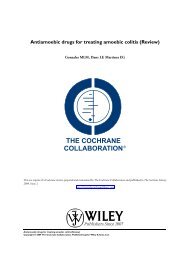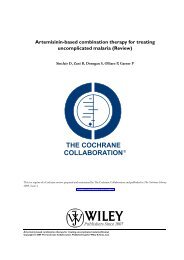Legislative smoking bans for reducing secondhand smoke exposure ...
Legislative smoking bans for reducing secondhand smoke exposure ...
Legislative smoking bans for reducing secondhand smoke exposure ...
Create successful ePaper yourself
Turn your PDF publications into a flip-book with our unique Google optimized e-Paper software.
2007; Khuder 2007; Sargent 2004; Seo 2007); three in Italy<br />
(Barone-Aldesi 2006; Cesaroni 2008; Vasselli 2008); one in Scotland<br />
(Pell 2008) and one in Canada (Lemstra 2008). Four studies<br />
had control groups without a ban. The impact on admissions <strong>for</strong><br />
AMI showed a reduction in numbers in all 10 studies. (Analysis<br />
3.4) Two further studies showed an impact on deaths from coronary<br />
heart disease (Fichtenberg 2000) and better prognosis post<br />
acute coronary syndrome amongst non <strong>smoke</strong>rs (Pell 2009) following<br />
legislation. One study measured individual <strong>exposure</strong> to active<br />
<strong>smoking</strong> (Pell 2008) and three further studies used measures<br />
of population <strong>smoking</strong> prevalence and/or cigarette consumption,<br />
not individual <strong>exposure</strong>. Two of these studies measured cotinine<br />
levels and one examined pollution reduction by measuring PM10<br />
(Cesaroni 2008). It is evident that in every study looking at an effect<br />
of <strong>smoking</strong> legislation on acute coronary syndrome, the overall<br />
impact of the legislation was positive.<br />
4 Other outcomes<br />
Other outcomes such as support <strong>for</strong> the ban, compliance with the<br />
legislation, air quality, economic impact of the legislation and any<br />
adverse effects were reported from the included studies.<br />
Support <strong>for</strong> the ban<br />
Studies also reported acceptability or support of <strong>smoking</strong> <strong>bans</strong><br />
as an outcome. Support <strong>for</strong> the legislation increased in nine of<br />
the studies (Biener 2007; Fong 2006; Fowkes 2008; Gallus 2007;<br />
Heloma 2003; Hyland 2009; Larsson 2008; Palmersheim 2006;<br />
Waa 2006). Two studies showed no significant change in support<br />
pre and post ban. One study showed greater than 70% support<br />
post ban with greater support amongst <strong>smoke</strong>rs who had stopped<br />
or tried to stop <strong>smoking</strong>. Four studies showed that support was<br />
greater amongst non <strong>smoke</strong>rs than <strong>smoke</strong>rs but support <strong>for</strong> the<br />
<strong>smoking</strong> ban legislation increased <strong>for</strong> both <strong>smoke</strong>rs and non <strong>smoke</strong>rs<br />
after implementation.<br />
Compliance with the legislation<br />
Nine studies were included in this review which also reported<br />
compliance with <strong>smoking</strong> <strong>bans</strong> as an outcome (Biener 2007;<br />
Fernando 2007; Fong 2006; Galán 2007; Goodman 2007; Gotz<br />
2008; Heloma 2003; Lemstra 2008; Mulcahy 2005). Four studies<br />
reported full compliance in no <strong>smoking</strong> hospitality venues,<br />
three others reported significant decrease in observed <strong>smoking</strong> or<br />
<strong>smoking</strong> in the workplace. Two others showed compliance with<br />
the ban in terms of signage. Only one study reported that 31%<br />
of <strong>smoke</strong>rs reported no change post ban or seeing more <strong>smoking</strong><br />
after implementation of ban.<br />
Air quality<br />
Eight included studies in this review reported environmental measures<br />
of air quality (Cesaroni 2008; Ellingsen 2006; Goodman<br />
2007; Gotz 2008; Heloma 2003; Larsson 2008; Mulcahy 2005;<br />
Semple 2007). The impact was clear with all studies showing a<br />
significant reduction in levels of markers of poor air quality such<br />
as nicotine, dust, benzene and particulate matter.<br />
Economic impact of the <strong>smoking</strong> ban legislation<br />
Seven studies reviewed the economic impact of the <strong>smoking</strong><br />
legislation (Biener 2007; Cesaroni 2008; Gallus 2007; Helakorpi<br />
2008; Hyland 2009; Juster 2007; Waa 2006). Three reported<br />
there was no significant decrease on bar patronage as measured<br />
pre and post ban, two of these also reported no significant decrease<br />
on restaurant attendance with one of them showing a significant<br />
increase in numbers of non<strong>smoke</strong>rs attending restaurants.<br />
Two of the studies examined the numbers of cigarette sales pre<br />
and post ban and found a significant reduction in cigarette sales<br />
post introduction of legislation. One study reported on savings<br />
in health care expenditure attributable to a decrease in MI admissions<br />
post introduction of legislation (Juster 2007). One study<br />
included economic indicators in its model assessing the impact of<br />
a ban (Helakorpi 2008). Many other studies looked at the economic<br />
impact of <strong>smoking</strong> legislation, however these studies did<br />
not examine health outcomes and thus were excluded.<br />
Adverse effects<br />
Three studies which we included in this review report on other<br />
adverse or otherwise negative effects of implementing <strong>smoking</strong><br />
<strong>bans</strong> (Fernando 2007, Gilpin 2002, Mulcahy 2005). All of the<br />
studies reported that there was still a potential <strong>for</strong> <strong>smoke</strong> from<br />
outdoor areas to drift into indoor areas.<br />
D I S C U S S I O N<br />
Legislation restricting or prohibiting <strong>smoking</strong> in workplaces and<br />
public places is a public health measure at the population level.<br />
There were no randomized controlled trials where the intervention<br />
of the study was a <strong>smoking</strong> ban. The predominant study design<br />
when evaluating the effectiveness of <strong>smoking</strong> <strong>bans</strong> were uncontrolled<br />
studies with a be<strong>for</strong>e and after design which were often<br />
unable to control <strong>for</strong> possible confounders and changes in secular<br />
trends over time. Nonetheless the balance of evidence from both<br />
the repeated cross-sectional and cohort studies strongly suggests<br />
that the primary objective of <strong>reducing</strong> tobacco <strong>smoke</strong> <strong>exposure</strong><br />
was achieved, particularly amongst hospitality workers. This was<br />
validated in many studies by cotinine measures and corroborated<br />
in some cases also by improvements in air quality. Exposure to <strong>secondhand</strong><br />
<strong>smoke</strong> in workplaces, public places, bars and restaurants<br />
<strong>Legislative</strong> <strong>smoking</strong> <strong>bans</strong> <strong>for</strong> <strong>reducing</strong> <strong>secondhand</strong> <strong>smoke</strong> <strong>exposure</strong>, <strong>smoking</strong> prevalence and tobacco consumption (Review)<br />
Copyright © 2010 The Cochrane Collaboration. Published by John Wiley & Sons, Ltd.<br />
10








